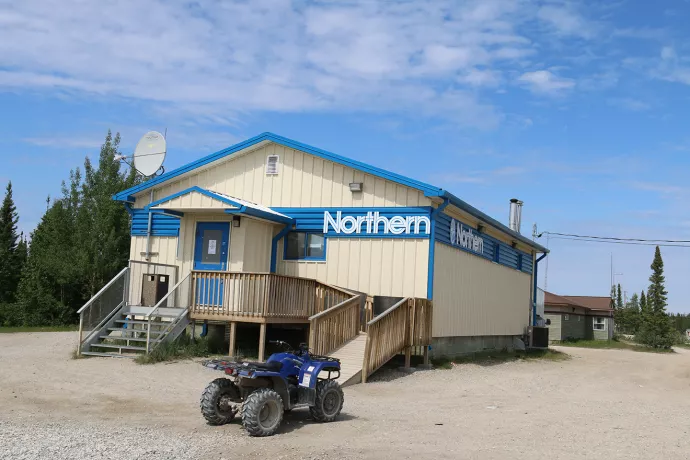
Grocers fail to pass along full Nutrition North food subsidy to shoppers, study shows
Hunger is such a dire problem in Canada’s remote northern communities that the federal government offers a food subsidy program through retail grocery stores. But a new study has discovered that while retailers are obligated to pass along the full amount of the subsidy to consumers, that’s not happening.
For every one dollar in subsidy that the large retail companies received through the Nutrition North Canada program, the average price for the consumer has gone down by only 67 cents, says study co-author Tracey Galloway, an associate professor in U of T Mississauga’s department of anthropology.
So where did the other 33 cents on every dollar go? “It went to the retailers who received it,” Galloway says. “How they use those additional funds is not captured in any metric that’s made available to us.”
Wherever the extra money ended up, it didn’t go to consumers, she says. With very low household incomes and food prices double or triple those in southern Canada, remote northern communities have shockingly high rates of food insecurity. “At least two-thirds of households in northern communities don’t have enough nutritious food, or enough food at all, and it’s more common in households with children,” says Galloway, who has been studying the issue for more than a decade.
She collaborated on this study, just published in the Journal of Public Economics, with Nicholas Li, an assistant professor in the department of economics at Toronto Metropolitan University. They used publicly available information collected by the government and posted on its Nutrition North website. “This was always intended to provide some accountability,” Li says. “But no one had ever actually used that information to try to see how much of those subsidies was passed through to the consumer.”
Galloway and Li looked at 100-plus isolated communities across several provinces and territories, such as Attawapiskat and Fort Severn in Northern Ontario, Aklavik in Northwest Territories, and Gjoa Haven, Resolute and Pond Inlet in Nunavut. Most of these communities lack year-round access by road, water or rail and are hundreds of kilometres away from larger service hubs.
While the communities, averaging 1,000 people, are mostly Inuit, First Nations or Métis, very few of the retail stores are Indigenous-owned. Most belong to large, profitable companies based in southern Canada. By far the most dominant retailer is the North West Company (which operates as Northern Stores), with its head office in Winnipeg. It receives half of the $120 million in annual Nutrition North subsidies. Its largest competitors are Arctic Co-operatives Limited and Fédération des coopératives du Nouveau-Québec, with headquarters respectively in Winnipeg and Montreal. Galloway says, “Evidence like this might lead you to question why so many taxpayer dollars are moving into the coffers of a southern-owned retailer operating in these communities, and often operating as a monopoly.”
The researchers found a stark difference between communities with one store and those with two stores. In early 2019, for example, when the federal government raised the subsidies, retailers in communities with two or more stores passed along 84 cents on the dollar to consumers. But where there was a monopoly and the single retail store faced no competition, consumers received only 55 cents.
The Nutrition North program, begun in 2011, was supposed to be an improvement over the old Food Mail system, which was a transportation subsidy administered by Canada Post to deliver food to isolated communities. But retailers objected to Canada Post’s monopoly on food transport, consumers complained that grocery prices remained high, and the program subsidized all food whether nutritious or not. Nutrition North was intended to solve these problems by paying retailers directly, placing higher subsidies on perishable foods such as vegetables, fruits, eggs, fresh milk and infant foods, and creating a system of accountability whereby retailers would have to report data into a sophisticated monitoring system.
Many Indigenous entrepreneurs started up small grocery stores, but they weren’t eligible for the subsidies because the reporting system can be labour-intensive, and they were forced to close. Moreover, accountability measures have rarely been enforced, with good reason: kicking a non-compliant retailer out of the program would eliminate the subsidy altogether, harming the consumer even more.
The researchers say there’s room for optimism. The federal government has formed a working group and is consulting with community members, with a long-term goal of creating a more equitable and accountable program. Galloway and Li have partnered with Kimberly Fairman, an Inuk resident of Yellowknife, NWT, and executive director at the Institute for Circumpolar Health Research, to compare federal and local concepts of what food security supports should look like.
But in the short term, the researchers want to see clear data transparency, with public reporting of prices for every subsidized item, so consumers – and government – can see where the money is going. “We need action soon because people are hungry and are going without,” Galloway says. “To say it’s urgent is a vast understatement.”
Read more:
Hunger in the North: UTM anthropologist Tracey Galloway believes Inuit communities have the solution
